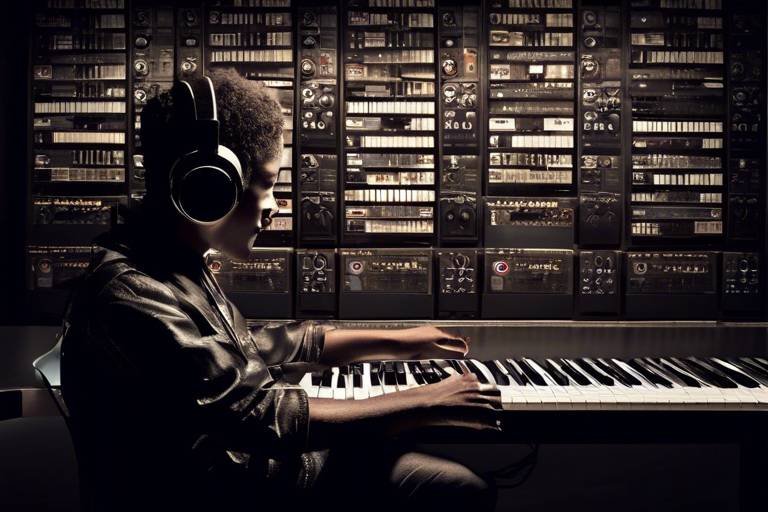How Technology is Reshaping the Music Industry
The music industry has undergone a remarkable transformation in recent years, primarily driven by the rapid advancement of technology. It's as if we've been handed a magic wand that has completely reshaped how music is produced, distributed, and consumed. Gone are the days when artists relied solely on traditional record labels and expensive studio time to get their music heard. Today, technology allows musicians to create, share, and monetize their work in ways that were once unimaginable. This article explores the transformative impact of technology on the music industry, examining changes in production, distribution, and consumption, as well as the challenges and opportunities presented by these advancements.
Advancements in technology have revolutionized music production, enabling artists to create high-quality recordings from their own homes. Imagine a world where you can craft a hit song without stepping foot in a recording studio! This shift from traditional studios to digital platforms has not only democratized music production but also changed the landscape for musicians. With tools like Digital Audio Workstations (DAWs) such as Ableton Live, FL Studio, and GarageBand, artists can produce professional-quality music with just a laptop and a microphone.
Moreover, the accessibility of online tutorials and communities has empowered aspiring musicians to learn the craft at their own pace. This newfound freedom allows for a more diverse range of sounds and genres, as artists from all walks of life can experiment and innovate without the constraints of conventional music production. The implications for musicians are profound: they can now take control of their creative process, leading to a surge of independent artists making waves in the industry.
The rise of streaming services has fundamentally altered how music is consumed. Platforms like Spotify and Apple Music have become the go-to sources for music lovers, changing the way we listen to and discover new tracks. No longer do we have to purchase entire albums; instead, we can access millions of songs at our fingertips for a monthly subscription fee. This shift has created a new paradigm for music consumption, where playlists and curated content reign supreme.
As streaming becomes the dominant way to access music, revenue models are shifting dramatically. Artists are adapting to lower per-stream payouts, which has led many to explore alternative income streams. For instance, musicians are increasingly focusing on live performances and merchandising as primary revenue sources. The chart below illustrates the changing landscape of music revenue:
| Revenue Source | Traditional Model | Current Model |
|---|---|---|
| Album Sales | High revenue from physical and digital sales | Lower revenue from streaming per play |
| Live Performances | Supplementary income | Main income source for many artists |
| Merchandising | Occasional revenue | Significant revenue stream |
With traditional album sales declining, many artists are turning to merchandising and live performances as primary revenue sources. Innovative strategies musicians are using to enhance their earnings include:
- Exclusive merchandise: Limited edition items that resonate with fans.
- VIP experiences: Offering fans unique opportunities to meet their favorite artists.
- Live streaming concerts: Reaching global audiences beyond geographical limitations.
Technology has enabled artists to connect with fans more intimately than ever before. Social media platforms like Instagram and Twitter allow musicians to share their creative processes, personal stories, and behind-the-scenes moments, fostering a sense of community. Crowdfunding platforms like Patreon and Kickstarter empower fans to support their favorite artists directly, creating a more sustainable model for music creation.
However, as technology evolves, so do the challenges of copyright infringement and music piracy. The ongoing battle between artists and platforms over intellectual property rights raises important questions about the future of music ownership. It's a complex issue that requires a balance between protecting artists' rights and embracing the accessibility that technology provides.
Social media has become a crucial tool for music marketing and promotion. Platforms like Instagram and TikTok are shaping the way artists reach new audiences. The ability to share snippets of songs, engage with fans, and participate in viral trends has transformed the promotional landscape.
Viral trends on social media can catapult unknown artists into the spotlight almost overnight. Think about how a catchy dance challenge on TikTok can lead to millions of streams for a new song! This phenomenon emphasizes the power of social media in music discovery and popularity.
Artists are increasingly using social media to build their personal brands. By sharing their unique stories, values, and artistic visions, musicians can cultivate an online presence that resonates with their audience. Effective strategies for engaging with fans include:
- Consistent content creation: Regularly posting updates, music snippets, and personal anecdotes.
- Authenticity: Being genuine and relatable in interactions.
- Engagement: Responding to fan comments and messages to build a loyal community.
Q1: How has technology changed music production?
A1: Technology has made high-quality music production accessible to anyone with a computer, allowing artists to create from home without the need for expensive studio time.
Q2: What is the impact of streaming services on artist revenue?
A2: Streaming services have shifted revenue models, leading to lower per-stream payouts, prompting artists to explore alternative income sources like live performances and merchandising.
Q3: How do social media platforms influence music promotion?
A3: Social media platforms allow artists to connect with fans, share music, and participate in viral trends, significantly enhancing their promotional efforts.

The Evolution of Music Production
Advancements in technology have completely transformed the landscape of music production. Gone are the days when artists had to book expensive studio time and rely on a team of sound engineers to bring their musical visions to life. Today, musicians can create high-quality recordings from the comfort of their own homes, thanks to powerful software and affordable equipment. This shift has democratized music production, allowing a wider array of voices to emerge and be heard.
One of the most significant changes has been the move from traditional recording studios to digital platforms. With the advent of Digital Audio Workstations (DAWs) like Ableton Live, Logic Pro, and FL Studio, artists can produce, mix, and master their music with just a laptop and a few essential tools. This accessibility has led to an explosion of creativity, enabling independent artists to experiment and innovate without the constraints of a conventional studio environment.
Moreover, the rise of cloud-based collaboration tools has further enhanced the production process. Artists can now collaborate with musicians and producers from around the globe, sharing files and ideas in real-time. This not only enriches the creative process but also fosters a sense of community among artists. Imagine a singer in New York working with a beatmaker in Tokyo, crafting a track that seamlessly blends their styles—this is the new reality of music production.
However, this evolution isn't without its challenges. While technology has made production more accessible, it has also flooded the market with content, making it harder for individual artists to stand out. With so much music available at our fingertips, listeners often find it overwhelming to discover new talent. As a result, artists must now focus not only on creating great music but also on marketing themselves effectively in an increasingly crowded space.
Despite these hurdles, the benefits of technological advancements in music production are undeniable. Artists can now harness affordable tools to produce music that rivals the quality of major label releases. Here’s a quick look at some of the key technologies that have reshaped music production:
| Technology | Impact on Production |
|---|---|
| Digital Audio Workstations (DAWs) | Allow for recording, editing, and mixing music at home. |
| Affordable Recording Equipment | Enables high-quality recordings without a hefty budget. |
| Cloud Collaboration Tools | Facilitates remote collaboration among artists worldwide. |
| Virtual Instruments and Plugins | Offers a wide range of sounds and effects to enhance music. |
In conclusion, the evolution of music production has opened up a world of possibilities for artists, allowing them to create and share their music like never before. While the challenges of standing out in a saturated market remain, the tools and technologies available today empower musicians to express their creativity fully. As we look to the future, it’s clear that technology will continue to play a pivotal role in shaping the music industry.
- What is a Digital Audio Workstation (DAW)?
A DAW is software used for recording, editing, and producing audio files. Popular examples include Ableton Live, Logic Pro, and FL Studio. - Can I produce music at home?
Yes, with the right software and equipment, anyone can produce music at home. Many artists start their careers this way. - How has technology changed music collaboration?
Technology has made it easier for artists to collaborate remotely, sharing files and ideas in real-time through cloud-based tools.

Streaming Services and Their Impact
The rise of streaming services has fundamentally transformed the way we consume music. Gone are the days when we had to buy entire albums or rely on radio play to discover new tunes. Now, with just a few clicks or taps, we can access millions of songs from the comfort of our homes or on the go. Platforms like Spotify, Apple Music, and Amazon Music have made it incredibly easy for listeners to explore a vast array of genres and artists, but this convenience comes with its own set of challenges and implications for the music industry.
One of the most significant impacts of streaming services is on artist revenue. In the past, musicians earned substantial income from physical album sales. However, with streaming, the payout model has dramatically shifted. Artists receive a fraction of a cent per stream, which means they need millions of streams just to make a living. This new reality has forced many artists to rethink their revenue strategies. For instance, some are now focusing on building a loyal fanbase that supports them through merchandise sales and live performances, rather than relying solely on streaming income.
To illustrate this shift, consider the following table that compares traditional album sales with streaming revenue:
| Revenue Source | Average Earnings per Unit | Units Needed for $10,000 |
|---|---|---|
| Physical Album Sales | $10 | 1,000 |
| Streaming (Spotify) | $0.004 | 2,500,000 |
This stark difference highlights the challenges artists face in the streaming era. To adapt, many are diversifying their income streams. For example, they might engage in crowdfunding for new projects, offer exclusive content to fans, or even collaborate with brands for sponsorship deals. The key is to create multiple avenues for income, which can help mitigate the financial strain caused by lower streaming payouts.
Another significant aspect of streaming services is their impact on listener habits. With the ability to create personalized playlists and discover new music through algorithms, listeners are now more likely to explore a wider range of artists and genres. This has led to the emergence of viral hits, where songs can explode in popularity overnight, often driven by social media trends. However, this rapid consumption of music can also lead to a fleeting attention span, making it challenging for artists to maintain long-term engagement with their audience.
Moreover, streaming services have democratized music access, allowing independent artists to reach global audiences without the need for a record label. This shift has empowered many musicians to take control of their careers, but it also means that the competition is fiercer than ever. As more artists enter the fray, standing out becomes increasingly challenging, leading to a saturated market where only a few can achieve mainstream success.
In conclusion, while streaming services have revolutionized how we access and enjoy music, they have also introduced a complex landscape for artists. The need for innovative revenue models, the importance of fan engagement, and the challenges of a competitive market are all factors that musicians must navigate in this new era. As technology continues to evolve, the music industry will likely keep adapting, presenting both exciting opportunities and daunting challenges for artists and fans alike.
- How do streaming services pay artists? Artists are paid based on the number of streams their songs receive, with payouts varying by platform.
- What are some alternative income streams for artists? Many artists focus on merchandise sales, live performances, and crowdfunding to supplement their income.
- Can independent artists succeed on streaming platforms? Yes, independent artists can reach global audiences through streaming, but they must find ways to stand out in a crowded market.

Changing Revenue Models
As we dive into the of the music industry, it’s essential to understand how the landscape has shifted dramatically in recent years. With the rise of streaming platforms, artists are finding themselves navigating a new economic reality. Gone are the days when a hit album could guarantee substantial sales and a comfortable living. Now, the music business resembles a complex puzzle, with each piece representing a different avenue for revenue generation.
To illustrate this shift, let’s consider the traditional revenue model that relied heavily on album sales. Artists would invest time and resources into creating an album, and upon its release, they could expect a significant return on their investment through physical sales and digital downloads. However, with the advent of streaming services like Spotify and Apple Music, the dynamics have changed. Artists now receive a fraction of a cent for each stream, which has drastically reduced the revenue they once enjoyed from album sales.
This dramatic decline in per-stream payouts has forced musicians to rethink their financial strategies. Many are now diversifying their income streams to adapt to this new reality. Here are several alternative revenue sources that artists are exploring:
- Merchandising: Selling branded merchandise has become a vital income source. Artists are leveraging their fan base to sell everything from t-shirts to vinyl records, often during live shows or through online stores.
- Live Performances: With album sales declining, artists are prioritizing live performances as a primary revenue source. Concert tours can generate significant income, and many musicians are now focusing on creating unforgettable live experiences to draw in crowds.
- Crowdfunding: Platforms like Patreon and Kickstarter allow fans to support artists directly, providing a steady income stream while fostering a sense of community.
Moreover, the shift to a digital-first approach means that artists must also consider how to monetize their online presence. This includes everything from exclusive content for subscribers to virtual concerts that can reach global audiences. The challenge lies in finding the right balance between producing quality music and engaging with fans through various platforms.
In this new era, artists are not just musicians; they are also entrepreneurs. They must learn how to market themselves effectively and navigate the complexities of the digital landscape. Each social media post, every interaction with fans, and all the content they produce contribute to their brand identity and, ultimately, their revenue potential.
As we look ahead, it’s clear that the music industry will continue to evolve. Artists who can adapt to these changing revenue models will be the ones who thrive in this new environment. They will need to embrace technology, innovate their approaches to fan engagement, and continually seek out new opportunities for monetization. The future may be uncertain, but one thing is for sure: the music industry is alive and kicking, ready for those who dare to embrace change.
- How do streaming services affect artist income? Streaming services pay artists a small fraction per stream, which has led to a significant decline in traditional album sales.
- What are some alternative revenue sources for musicians? Artists are increasingly turning to merchandise sales, live performances, and crowdfunding as alternative income streams.
- Can social media help musicians earn money? Yes, social media can be a powerful tool for musicians to build their brand, engage with fans, and promote their merchandise or shows.

Merchandising and Live Performances
As the landscape of the music industry continues to evolve, artists are finding innovative ways to generate revenue beyond traditional album sales. Merchandising and live performances have emerged as vital sources of income for musicians navigating this new terrain. In a world where streaming services dominate, the importance of these revenue streams cannot be overstated. Artists are now turning their attention to creating unique merchandise that resonates with their fanbase and enhances their overall brand.
Imagine walking into a concert and being surrounded by an array of colorful merchandise that reflects the artist's unique style and message. This is the power of merchandising. From t-shirts and hoodies to limited edition vinyl and posters, artists are leveraging their creativity to design products that fans want to own. Not only does this foster a deeper connection between the artist and their audience, but it also serves as a significant revenue generator. In fact, many artists report that merchandise sales can sometimes surpass their earnings from streaming platforms.
Moreover, the rise of social media has made it easier than ever for artists to promote their merchandise. Platforms like Instagram, Facebook, and TikTok allow musicians to showcase their products directly to fans, creating a buzz that can lead to increased sales. For example, an artist might post a behind-the-scenes video of their latest merchandise drop, encouraging fans to purchase items before they sell out. This direct line of communication not only boosts sales but also strengthens the artist-fan relationship.
Live performances, on the other hand, provide an unparalleled experience for both artists and fans. Concerts and festivals offer a chance for musicians to connect with their audience on a personal level, creating memories that last a lifetime. As artists plan their tours, they often incorporate unique elements such as special guest appearances, interactive stage setups, and exclusive merchandise available only at the show. This not only enhances the concert experience but also incentivizes fans to attend live events.
In recent years, many artists have embraced the concept of VIP experiences, where fans can purchase premium packages that include meet-and-greets, exclusive access to soundchecks, and limited-edition merchandise. These offerings cater to the passionate fanbase willing to invest in unforgettable moments with their favorite artists. The combination of live performances and merchandising creates a win-win scenario, where fans feel valued and artists can sustain their careers.
However, the challenges posed by the pandemic have forced many artists to adapt their strategies. With live events being canceled or postponed, musicians have turned to virtual concerts and online merchandise sales as alternative revenue sources. Platforms like YouTube and Twitch have become popular venues for live-streamed performances, allowing artists to reach global audiences while selling merchandise directly through their websites or social media channels.
In conclusion, merchandising and live performances have become essential components of an artist's revenue strategy in today’s music industry. By embracing these avenues, musicians can not only enhance their income but also cultivate a loyal fanbase that feels personally connected to their work. As technology continues to advance, the possibilities for creative merchandising and engaging live experiences will only expand, paving the way for a more dynamic and sustainable music industry.
- How can artists effectively market their merchandise? Artists can utilize social media platforms, collaborate with influencers, and create engaging content to promote their merchandise.
- What types of merchandise are most popular among fans? Apparel, accessories, and exclusive collectibles tend to be the most sought after by fans.
- How can artists enhance their live performance experience? Incorporating unique stage designs, interactive elements, and VIP packages can significantly enhance the concert experience for fans.
- What are the benefits of virtual concerts? Virtual concerts allow artists to reach wider audiences, reduce touring costs, and provide fans with accessible entertainment from the comfort of their homes.

Fan Engagement through Technology
In today's digital age, the way artists connect with their fans has undergone a dramatic transformation, thanks to technology. No longer are musicians confined to the traditional methods of fan engagement, such as meet-and-greets or fan clubs. Instead, they now have a plethora of tools at their disposal to create a more intimate and personal relationship with their audience. Social media platforms like Instagram, Twitter, and TikTok have become essential for artists to not only promote their music but also to foster a sense of community among their fans.
Imagine this: you’re an artist, and you just dropped a new single. Instead of waiting for the radio to play it or for a magazine to review it, you can instantly share it with your followers. You can post behind-the-scenes content, share your creative process, or even host live Q&A sessions. This immediate access allows fans to feel like they are part of your journey, creating a bond that was previously unimaginable. Social media has transformed the artist-fan relationship from a one-sided broadcast into a dynamic dialogue.
Moreover, technology has enabled artists to engage their fans in innovative ways. For example, crowdfunding platforms like Patreon allow musicians to offer exclusive content to their supporters in exchange for financial support. This not only provides artists with a steady income stream but also gives fans a sense of ownership and involvement in the creative process. They can feel like they are directly contributing to the music they love, which in turn deepens their loyalty.
Another exciting development is the rise of direct-to-fan platforms, where artists can sell merchandise, concert tickets, and even personalized experiences without the need for intermediaries. This not only enhances the fan experience but also allows artists to retain a larger share of the revenue generated. Imagine being able to buy a limited-edition vinyl directly from your favorite artist, complete with a handwritten note. This level of personalization is what fans crave, and technology is making it possible.
However, while technology offers incredible opportunities for fan engagement, it also presents challenges. With so many platforms and channels available, it can be overwhelming for artists to maintain a consistent and authentic presence. They must navigate the fine line between engaging their audience and oversaturating their feeds. The key is to find a balance that keeps fans excited without feeling bombarded.
In conclusion, technology has revolutionized fan engagement in the music industry. By leveraging social media, crowdfunding, and direct-to-fan platforms, artists can create meaningful connections with their audience that go beyond just music. This evolving landscape not only empowers musicians but also enriches the fan experience, making it more interactive and personal than ever before. As we look to the future, it’s clear that the relationship between artists and fans will continue to grow and evolve, driven by the advancements in technology.
- How can artists effectively engage with their fans online? Artists can engage with fans by using social media platforms to share personal stories, behind-the-scenes content, and by hosting live events or Q&A sessions.
- What role does crowdfunding play in fan engagement? Crowdfunding allows fans to support their favorite artists financially, often in exchange for exclusive content or experiences, fostering a deeper connection.
- Are there risks associated with using technology for fan engagement? Yes, artists must be careful not to overwhelm their audience with too much content and should strive for authenticity in their interactions.

Challenges of Piracy and Copyright Issues
The music industry has always been a battleground for copyright and piracy issues, and with the rapid advancement of technology, the stakes have never been higher. As artists and producers strive to protect their creations, they face a multitude of challenges that threaten their revenue and artistic integrity. The digital landscape has made it easier than ever for music to be shared, often without compensation to the creators. This raises a critical question: how do artists safeguard their work in an age where a single click can lead to unauthorized distribution?
One of the core challenges lies in the sheer volume of content available online. With platforms like YouTube, SoundCloud, and countless torrent sites, music can be accessed and shared at lightning speed. Unfortunately, this means that piracy is rampant, with millions of downloads happening daily without artists seeing a dime. According to recent studies, the music industry loses billions each year due to piracy, which can severely impact emerging artists who rely on sales for their livelihood.
Moreover, the traditional copyright laws that were once effective in protecting artists are struggling to keep pace with the evolving digital landscape. Many artists find themselves in a complex web of legal battles, trying to navigate the labyrinth of copyright claims and infringements. The Digital Millennium Copyright Act (DMCA) was a step in the right direction, but it often falls short in providing adequate protection against the misuse of music online. For instance, while DMCA takedown notices can remove infringing content, the process can be cumbersome and slow, often leaving artists vulnerable in the meantime.
Another significant issue is the disparity in enforcement. While major labels often have the resources to pursue legal action against infringers, independent artists frequently lack the means to protect their work. This inequity creates a challenging environment where only those with substantial backing can effectively combat piracy. In many cases, the cost of legal action can outweigh the potential benefits, leaving artists with no choice but to accept the risks associated with digital distribution.
Despite these challenges, there are emerging solutions that artists and industry stakeholders are exploring to combat piracy and protect their rights:
- Blockchain Technology: This innovative technology offers a transparent way to track music ownership and ensure artists receive fair compensation for their work.
- Digital Rights Management (DRM): While not foolproof, DRM tools can help prevent unauthorized copying and distribution of music.
- Education and Awareness: Increasing awareness about the value of music and the impact of piracy can encourage fans to support artists through legitimate channels.
In conclusion, while technology has opened new doors for music distribution and consumption, it has also introduced significant challenges regarding piracy and copyright issues. As artists navigate this complex landscape, they must remain vigilant and proactive in protecting their work. The fight against piracy is far from over, and it requires collective efforts from artists, labels, and fans alike to ensure that creativity is rewarded and respected in the digital age.
- What is music piracy? Music piracy refers to the unauthorized copying and distribution of music, which deprives artists of revenue.
- How can artists protect their music? Artists can protect their music through copyright registration, using digital rights management tools, and leveraging technology like blockchain.
- What are the consequences of music piracy? Music piracy can lead to significant financial losses for artists and the industry, affecting their ability to create new music.
- How does social media impact music piracy? While social media can promote music, it can also facilitate piracy by making it easier to share unauthorized content.

The Role of Social Media in Music Promotion
In today's digital age, social media has become a game-changer for music promotion. Gone are the days when artists relied solely on traditional media outlets like radio and television to get their music heard. Now, platforms like Instagram, TikTok, and Twitter serve as powerful tools that allow musicians to reach audiences directly, engage with fans, and build their brands in ways that were previously unimaginable.
One of the most significant advantages of social media is its ability to connect artists with fans on a personal level. Through behind-the-scenes content, live streams, and interactive posts, musicians can share their creative processes, thoughts, and even daily lives with their followers. This level of accessibility fosters a sense of community and loyalty among fans, making them feel like they are part of the artist's journey. It's akin to having a backstage pass to the concert of life!
Moreover, social media platforms are not just about interaction; they are also catalysts for viral trends. A catchy song or a unique dance challenge can explode overnight, propelling an unknown artist into the limelight. For instance, TikTok has become notorious for launching hit songs that were initially overlooked by mainstream channels. This phenomenon illustrates how social media can democratize music promotion, allowing anyone with talent and creativity to gain recognition.
To maximize their impact, artists often employ various strategies on social media. Some of these include:
- Consistent Posting: Regular updates keep followers engaged and informed about new releases, tours, and personal insights.
- Collaborations: Working with other artists or influencers can expose musicians to new audiences, creating a win-win situation for all parties involved.
- Engaging Content: Whether it's fun challenges, Q&A sessions, or fan shoutouts, interactive content keeps fans coming back for more.
Additionally, social media provides a platform for targeted advertising. Artists can create ads that reach specific demographics, ensuring that their music is heard by the right people. This capability is particularly valuable for emerging artists looking to carve out a niche in a crowded market. By analyzing engagement metrics, musicians can adjust their strategies in real time, optimizing their promotional efforts for maximum impact.
However, it’s not all sunshine and rainbows. The fast-paced nature of social media can also lead to challenges. Artists must constantly adapt to changing algorithms and trends, which can be exhausting. Furthermore, the pressure to maintain a perfect online persona can sometimes overshadow the music itself, creating a conflict between authenticity and marketability.
Despite these challenges, the role of social media in music promotion is undeniable. It has transformed how artists connect with their audience, enabling them to build a personal brand that resonates with fans. As technology continues to evolve, one can only imagine the new avenues artists will explore for promotion and engagement. The future of music promotion is bright, and social media is at the forefront of this exciting revolution.
- How can social media help an emerging artist?
Social media provides a platform for exposure and interaction with potential fans, allowing emerging artists to showcase their talent and connect with audiences directly. - What are the best platforms for music promotion?
While platforms like Instagram and TikTok are popular, it often depends on the artist's target demographic. Facebook and Twitter can also be effective for reaching different audiences. - How important is engagement with fans on social media?
Engagement is crucial as it fosters loyalty and builds a community around the artist, making fans feel valued and connected.

Viral Trends and Their Influence
In today's fast-paced digital world, viral trends have become the lifeblood of the music industry, acting as a powerful catalyst for artists looking to break into the mainstream. Just think about it: one catchy hook or a quirky dance challenge can send an unknown artist skyrocketing to fame overnight! Platforms like TikTok and Instagram have transformed the way music is discovered and consumed, allowing songs to gain traction through user-generated content. This phenomenon has not only changed how we listen to music but also how artists create and promote their work.
When a song goes viral, it often leads to a ripple effect that can significantly boost an artist's visibility. For instance, a track that becomes the soundtrack to a trending dance challenge can see millions of views and shares, leading to increased streams on platforms like Spotify and Apple Music. This is not just a coincidence; it’s a carefully orchestrated dance between creativity and technology. Artists are now more aware than ever of the importance of social media presence and how it can be leveraged to engage with fans. The question is, how can artists harness these trends to their advantage?
Let’s break it down a bit further. Here are some key ways viral trends influence the music landscape:
- Increased Exposure: A viral song can reach audiences that traditional marketing methods might miss. This exposure can lead to opportunities for live performances, collaborations, and even record deals.
- Engagement with Fans: Artists can interact directly with their audience through comments, shares, and challenges, creating a sense of community and loyalty.
- Impact on Chart Performance: Viral hits often lead to significant jumps on music charts, as streaming numbers soar in response to the trend.
Moreover, the nature of viral trends is that they are often fleeting. What’s hot today might be forgotten tomorrow. This creates a unique challenge for artists: they must stay relevant and continuously innovate to keep their audience engaged. Many musicians are now adopting a “trend-savvy” approach, where they actively participate in or create trends that resonate with their music. This requires not just talent, but also a keen sense of timing and an understanding of the digital landscape.
One of the most notable examples of this is the song "Old Town Road" by Lil Nas X, which became a massive hit largely due to its viral success on TikTok. The song's catchy beat and relatable lyrics made it perfect for various challenges, leading to millions of posts and shares. This illustrates how a single viral moment can redefine an artist's career and lead to unprecedented opportunities.
In conclusion, viral trends are not merely a passing phase; they represent a new era in music promotion and consumption. As artists continue to adapt to these changes, the music industry will likely see even more innovative ways to connect with audiences. The challenge remains: how can artists not just catch the wave of a viral trend but also ride it sustainably? The answer lies in creativity, engagement, and a willingness to embrace the ever-evolving digital landscape.
- How can an artist create a viral trend?
Creating a viral trend often involves a catchy song, an engaging concept, and a strong social media presence. Artists should focus on creating relatable content that encourages audience participation. - What role does TikTok play in music promotion?
TikTok has become a powerful platform for music discovery, allowing users to create short videos that often feature snippets of songs. This can lead to increased streams and popularity for the artists involved. - Can viral trends sustain an artist's career?
While viral trends can provide a significant boost, sustaining a career requires ongoing engagement with fans, quality music production, and adaptability to new trends.

Building a Personal Brand
In today's digital age, is no longer just an option for artists; it’s a necessity. With the vast sea of talent available online, how can a musician stand out? The answer lies in creating a unique and authentic identity that resonates with fans. Think of your personal brand as your musical fingerprint—something that’s distinctly you and can’t be replicated.
Social media platforms like Instagram, TikTok, and Twitter serve as the perfect canvas for artists to paint their personal brand. They allow musicians to share their stories, showcase their personalities, and connect with fans on a deeper level. But it’s not just about posting your latest track; it’s about engaging your audience and creating a community around your music. For instance, behind-the-scenes content, live Q&A sessions, and interactive polls can make fans feel like they’re part of your journey.
To effectively build a personal brand, here are some essential strategies artists should consider:
- Authenticity: Be genuine in your interactions. Fans appreciate honesty and are more likely to connect with an artist who shares their true self.
- Consistency: Maintain a consistent aesthetic and message across all platforms. This helps in creating a recognizable brand image.
- Engagement: Regularly interact with your followers. Respond to comments, ask for feedback, and create content that encourages participation.
- Storytelling: Use storytelling to share your journey, struggles, and triumphs. This not only humanizes you but also makes your music relatable.
Additionally, collaborations with other artists and influencers can significantly boost your visibility. When you team up with someone who has a complementary style or audience, you’re not just sharing your music; you’re also sharing your brand with a whole new group of potential fans. Think of it as a musical handshake that can open doors to new opportunities.
Another crucial aspect of personal branding is the visual identity. This includes everything from your logo and album art to your fashion style and stage presence. These elements should reflect your music and personality, creating a cohesive look that fans can identify with. Just like a movie poster gives a glimpse into the film’s theme, your visuals should convey the essence of your music.
Finally, don't underestimate the power of analytics. Platforms like Instagram and Facebook provide insights into what type of content resonates most with your audience. Use this data to refine your strategy and focus on what works best. After all, a well-informed artist is a successful one!
In conclusion, building a personal brand is an ongoing process that requires time, effort, and creativity. By being authentic, engaging with fans, and maintaining a consistent image, artists can create a lasting impact in the music industry. So, are you ready to take your personal brand to the next level?
Q: How important is social media for musicians?
A: Social media is crucial for musicians as it provides a platform to connect with fans, promote music, and build a personal brand.
Q: What are some effective ways to engage with fans online?
A: Artists can engage with fans through live streams, Q&A sessions, behind-the-scenes content, and interactive polls.
Q: How can I maintain consistency in my personal brand?
A: Consistency can be achieved by using the same visual elements, messaging, and tone across all platforms.
Q: Is collaboration with other artists beneficial for building a brand?
A: Yes, collaborating with other artists can introduce you to new audiences and enhance your brand visibility.
Frequently Asked Questions
-
How has technology changed music production?
Technology has dramatically transformed music production by allowing artists to create high-quality recordings from their own homes. With the rise of digital audio workstations (DAWs) and affordable recording equipment, musicians no longer need to rely on traditional studios. This shift empowers artists to experiment more freely and produce music on their own terms, leading to a more diverse array of sounds and styles.
-
What impact do streaming services have on artists?
Streaming services like Spotify and Apple Music have fundamentally changed how music is consumed, but they also present challenges for artists. While these platforms provide access to a vast audience, the per-stream payouts are relatively low. Many artists are adapting by exploring alternative revenue streams, such as merchandise sales and live performances, to supplement their income.
-
How can artists engage with fans through technology?
Technology has opened up new avenues for artists to connect with their fans. Social media platforms, crowdfunding initiatives, and direct-to-fan services allow musicians to build closer relationships with their audience. By sharing behind-the-scenes content, engaging in conversations, and offering exclusive experiences, artists can foster a loyal fanbase that supports their work.
-
What are the challenges related to piracy and copyright in the music industry?
As technology evolves, so do the challenges surrounding music piracy and copyright infringement. Artists often find it difficult to protect their intellectual property in a digital landscape where unauthorized sharing is rampant. This ongoing battle necessitates a strong understanding of copyright laws and the implementation of strategies to safeguard their work while still reaching audiences effectively.
-
How is social media influencing music promotion?
Social media has become an essential tool for music promotion, enabling artists to reach new audiences in innovative ways. Platforms like Instagram and TikTok allow musicians to share their music, engage with fans, and participate in viral trends that can significantly boost their visibility. By leveraging these platforms, artists can create buzz around their releases and cultivate a dedicated following.
-
What role do viral trends play in music discovery?
Viral trends on social media can catapult unknown artists into the spotlight overnight. Challenges and memes often lead to increased visibility for specific songs, helping them gain traction and popularity. This phenomenon demonstrates how social media can serve as a powerful catalyst for music discovery, allowing new talent to break through traditional barriers.
-
How can artists build their personal brand on social media?
Building a personal brand on social media is crucial for artists looking to establish a strong online presence. Musicians can achieve this by consistently sharing authentic content, engaging with their audience, and showcasing their unique personality. By cultivating a recognizable brand, artists can create a lasting connection with fans and enhance their overall appeal in the competitive music landscape.



















